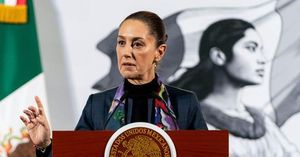Starbucks Corporation is gearing up to announce its first-quarter financial results on January 28, 2025, with analysts eagerly awaiting the latest updates from the Seattle-based coffee giant. Market predictions indicate a significant downturn, with projected earnings anticipated at 67 cents per share—down from 90 cents during the same period last year. The company has previously cited quarterly revenue estimates of $9.31 billion, compared to $9.43 billion year over year, marking another challenging quarter for the iconic brand.
Starbucks has not found itself on solid financial footing recently, as it has missed revenue estimates for four consecutive quarters and lowered its fiscal year guidance due to uncertainties surrounding CEO leadership transitions and overall performance.
On the trading front, shares of Starbucks appreciated by 0.4% to close at $100.79 during after-hours trading on the previous day, emphasizing the market's cautious optimism amid turbulent waters. Investors' interest is piqued by the company's annual dividend yield of 2.44%, translating to 61 cents per share, which raises questions about potential gains from regular dividend payouts amid fluctuated stock performances.
To ponder, how can investors maximize this dividend yield? Strategies indicate the need for significant investment levels to yield substantial monthly returns. For example, to secure $500 monthly from dividends—totaling $6,000 annually—an investment of around $245,949 or approximately 2,459 shares is required. Conversely, capturing $100 per month necessitates a more manageable investment of $49,210 or roughly 492 shares.
These calculations derive from the annual dividend divided by the desired income, reinforcing the importance of strategic planning when approaching investments centered on dividend yields. Notably, these yields can fluctuate based on stock price and changes to dividend payments, underscoring the dynamic nature of investing.
Starbucks' latest quarterly earnings summaries reveal both strengths and weaknesses within its operations. Despite fighting against inflation—which saw store operating expenses spike 9.1% year-over-year, resulting in lower operating income—the company presented revenues slightly higher than expected, aligning at $9.38 billion against Wall Street predictions. Comparison of sales trends paints a less favorable picture—alongside declines across key geographies, including the U.S. and China, it paints this as part of the broader challenges facing Starbucks.
While higher menu prices can result in short-term revenue growth, the overarching reality reveals quietly declining traffic. Reported declines of 4% year-over-year with noted pressure reveals the struggles Starbucks is enduring within the increasingly competitive marketplace. Chains like Dutch Bros have begun seeing growth with increased same-store sales—a stark reminder of the urgency for Starbucks to react.
The competitive coffee market continues to grow as various players, including third-wave coffee shops and fast-serve chains, take share. With this market evolution, Starbucks' emphasis has pivoted toward its rewards program and experiential approach, reflecting the brand's broader strategy shifts prompted by CEO Brian Niccol.
Indeed, Niccol, who took over as CEO several months ago, aims at fortifying Starbucks' premium status and improving service efficiency—promising to expedite cafe processes, including reducing wait times for brewed coffee orders. Combining operational adjustments intended to increase traffic flow will play equally against broader economic climates, including consumer spending sentiment—currently tightening under macroeconomic constraints.
Compounding these factors, concerning share performance valuations can play heavily on investor decisions. Starbucks maintains trading at over 30 times its price-earnings ratio, reflecting high expectations fizzing against competitive analysis. Despite positive reviews surrounding Niccol's operational pivots, vantage concerns remain belonging to existing financial ratios—questions arise if Starbucks can deliver tangible benefits soon, or if holding on proves too risky.
For investors observing closely, the outlook appears mixed. While initial earnings reports may show positive results, the question persists—can Starbucks compete adequately without catering to increasingly price-sensitive customers? With inflation cutting deep, individuals may forgo their daily cups, impacting traffic trends and promotional success.
Starbucks remains at the center of investor attention, and the upcoming results present both challenges and hopeful outlooks. The upcoming quarterly results and Niccol's professionally driven plans will aid investors as they assess the brand's direction and place within the ever-evolving coffee shop arena.



